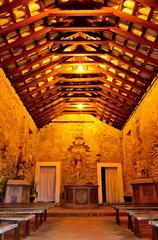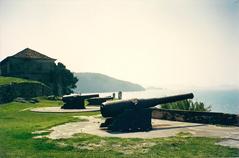
Santo Antônio de Lisboa: Visiting Hours, Tickets, and Historical Sites in Florianópolis
Date: 03/07/2025
Introduction
Santo Antônio de Lisboa, located on the northwest coast of Santa Catarina Island, is one of Florianópolis’s most cherished historic neighborhoods. Renowned for its Azorean heritage, colonial architecture, and vibrant cultural traditions, the neighborhood provides a living window into Brazil’s colonial and Azorean past. Visitors are drawn to its picturesque whitewashed houses with colorful trims, cobblestone streets, and waterfront gastronomy—especially its renowned oyster farming. This comprehensive guide covers visiting hours, ticketing information, historical landmarks, cultural experiences, and practical tips to help you fully immerse yourself in Santo Antônio de Lisboa (Floripa Trips; iPatrimônio; Carpe Mundi).
Historical Overview
Indigenous Roots and Pre-Colonial Context
Long before Portuguese colonization, the region was inhabited by Tupi-Guarani peoples, who relied on fishing, agriculture, and shellfish gathering. Archaeological discoveries, including sambaquis (prehistoric shell mounds), date back as far as 4,800 BCE, confirming an ancient and resilient coastal culture (Floripa Trips; iPatrimônio).
Portuguese Colonization and Azorean Influence
Portuguese settlement began in 1698, with the most significant wave of Azorean immigrants arriving between 1748 and 1756. Around 5,000 families were relocated as part of Portugal’s territorial strategy, shaping the architectural and cultural landscape of Santo Antônio de Lisboa. The Azorean legacy remains visible in the village’s urban layout, religious festivals, and distinctive architecture (iPatrimônio; Trilhas e Destinos).
Urban Development and Architectural Heritage
The centerpiece of the neighborhood is the Igreja de Nossa Senhora das Necessidades (1756), a prime example of Azorean religious architecture. Surrounding it are 18th and 19th-century buildings protected as municipal heritage, featuring thick masonry walls and gabled roofs. Preservation is a priority, with municipal and federal institutions like IPHAN ensuring the area’s historical integrity (Floripa Trips; iPatrimônio; Paranoá Journal; IPHAN/SC).
Social and Economic Evolution
Historically, Santo Antônio de Lisboa’s economy centered on agriculture and fishing. Today, oyster farming is a major economic driver, and the area is acclaimed for its seafood restaurants along the waterfront. Major festivals, such as the Feast of Santo Antônio and Carnival, reflect the enduring Azorean influence and attract both locals and tourists (Floripa Trips).
Visiting Santo Antônio de Lisboa: Practical Information
Location and Accessibility
Santo Antônio de Lisboa is about 14–16 km from downtown Florianópolis and 28 km from Hercílio Luz International Airport. It is accessible by car (via SC-401), bus, taxi/Uber, and even bicycle. Free parking is available near the waterfront, but can be limited during peak times (Carpe Mundi; Angelica Brunatto; Visite Floripa).
Visiting Hours and Tickets
- Historic Center & Waterfront: Open-access, year-round, 24/7.
- Igreja de Nossa Senhora das Necessidades: Open daily, 8:00 AM–6:00 PM. Entry is free; donations are welcome for preservation.
- Feira das Alfaias (Craft Market): Saturdays 11:00 AM–7:00 PM, Sundays and holidays 11:00 AM–6:00 PM.
- Casa Açoriana Artes e Tramoias Ilhoas (Art Gallery): 10:00 AM–7:00 PM daily (Viajali).
- Museu O Mundo Ovo de Eli Heil: Tuesday–Sunday, 10:00 AM–5:00 PM; entrance fee applies.
No tickets are required for general visits to the neighborhood or its main historical sites. Some museums and guided tours may charge a small fee.
Guided Tours
Local operators offer guided walking tours focusing on history, architecture, and gastronomy. Booking in advance is recommended, especially during high season (Carpe Mundi).
Accessibility
The historic center’s cobblestone streets add charm but can be challenging for visitors with mobility impairments. Many restaurants and shops are wheelchair accessible, but plan ahead if accessibility is a concern.
Key Historical and Cultural Landmarks
- Igreja de Nossa Senhora das Necessidades: Built in 1756, this church is the spiritual and architectural heart of the neighborhood (Trilhas e Destinos).
- Casarão Engenho dos Andrade: 19th-century manor that illustrates the region’s agricultural roots. Guided tours are available by prior arrangement (ND Mais).
- Praça Roldão Rocha Pires: Historic square, a lively hub for markets and community events.
- Azorean Colonial Houses: Many now house artisan shops and cafés, blending tradition with contemporary culture.
- Caminho dos Açores: Historic trail built in 1860, ideal for scenic walks and understanding the Azorean legacy.
Cultural Experiences
Festivals and Religious Celebrations
- Festa de Santo Antônio (June): Religious processions, masses, music, and folk dances like Pau de Fita and Boi de Mamão (livingtours.com).
- Carnival: Traditional and family-friendly, featuring the Bloco Gambá Xeiroso and Baiacu de Alguém, blending Azorean customs with modern celebrations (g1.globo.com; ndmais.com.br).
- Festa do Divino Espírito Santo: Major religious and cultural festival with vibrant community participation.
Artisanship and Handicrafts
- Casa da Renda: Demonstrations and sales of traditional bilro lacework and patchwork (ND Mais).
- Feira das Alfaias: Weekend artisan market featuring crafts, art, books, and local delicacies.
Gastronomy
Santo Antônio de Lisboa is celebrated for its seafood, particularly oysters grown in local farms. Restaurants along the Rota Gastronômica do Sol Poente serve fresh oysters, grilled fish, shrimp, and Azorean-inspired dishes. Cafés offer Portuguese pastries and sweets, perfect for relaxing afternoons (Carpe Mundi; ND Mais; Floripa Top).
Natural Attractions and Outdoor Activities
- Praia de Santo Antônio de Lisboa: Picturesque beach for strolls and sunset views, with calm waters and colorful fishing boats (Viajali).
- Praia do Sambaqui: Larger sandy beach nearby, offering more space and seafood restaurants.
- Boat Tours and Nature Trails: Opportunities for birdwatching, coastal exploration, and boat tours on the bay (Floripa Top).
Accommodation
- Pousadas: Quaint guesthouses like Pousada Mar de Dentro offer local charm (Café Viagem).
- Vacation Rentals: Colonial homes and modern apartments are available through platforms such as Airbnb.
- Nearby Hotels: Additional options are found in Jurerê, Cacupé, and downtown Florianópolis.
Practical Visitor Tips
- Best Time to Visit: Weekends and festivals for markets and lively atmosphere. Spring and autumn offer mild weather and fewer crowds.
- Transportation: Consider public transport or early arrival due to limited parking.
- Dress Code: Casual attire is appropriate; bring a jacket for cooler evenings.
- Safety: The area is safe, but standard precautions are recommended.
- Language: Portuguese is predominant; some English and Spanish spoken in tourist venues.
- Payment: Carry cash for markets and small purchases; ATMs are available.
Frequently Asked Questions (FAQ)
Q: What are the visiting hours for Santo Antônio de Lisboa’s main attractions?
A: The neighborhood is accessible at all times. The Igreja de Nossa Senhora das Necessidades is open daily from 8:00 AM to 6:00 PM.
Q: Are tickets required to visit?
A: Most attractions are free. Some museums and guided tours may charge a small fee.
Q: How do I get to Santo Antônio de Lisboa from downtown Florianópolis?
A: By car (20–30 minutes), bus, taxi, or Uber. The SC-401 highway provides easy access.
Q: Are guided tours available?
A: Yes, several local companies offer tours focusing on history, architecture, and gastronomy. Book in advance.
Q: Is Santo Antônio de Lisboa wheelchair accessible?
A: Some cobblestone streets present challenges, but many restaurants and shops are accessible.
Visuals and Digital Resources
Enhance your visit with virtual tours, interactive maps, and high-quality images available on official tourism websites (Visite Floripa; Carpe Mundi). Descriptive alt text such as “Santo Antônio de Lisboa visiting hours at the Church of Nossa Senhora das Necessidades” supports accessibility and SEO.
Responsible Tourism
Help preserve the tranquility and heritage of Santo Antônio de Lisboa by supporting local businesses, minimizing waste, and respecting community customs.
Conclusion and Recommendations
Santo Antônio de Lisboa is a vibrant testament to Florianópolis’s layered history and cultural richness. Its historic center, with landmarks such as the Igreja de Nossa Senhora das Necessidades, colonial mansions, and lively artisan markets, invites exploration and discovery. Whether you’re drawn by history, culture, or gastronomy, the neighborhood offers an authentic experience of Brazilian and Azorean heritage. Plan your visit during festivals or weekends for an immersive local atmosphere, and use digital resources like the Audiala app for up-to-date information and guided tours.
Call to Action
Ready to explore Santo Antônio de Lisboa? Download the Audiala app for maps, guided tours, and insider tips. For more information and travel inspiration, visit our related posts on Florianópolis historical sites and follow us on social media for updates and travel deals!









